This is the Closest Thing We Have to a True American Style Kitchen Knife
It makes a weird kind of thematic sense to make a bowie chef knife, because there’s so much debate about where the original design came from, and whether it was intended for fighting or hunting, or even intended to be useful in any specific way at all. So by all rights it should be redesigned for every purpose we can think of.
A chef knife makes as much sense as anything else knife makers have thrown the iconic clip point onto.
The bowie obsession isn’t completely unreasonable, though. Mattia Borrani Cutlery managed to take an idea that was in serious danger of being a fun novelty knife and turn it into an incredibly useful tool in the kitchen. The edge and weight lend themselves well to mass chopping, and the clip point has come in handy for a dozen different things from deseeding fruit to butterfly cutting meat.
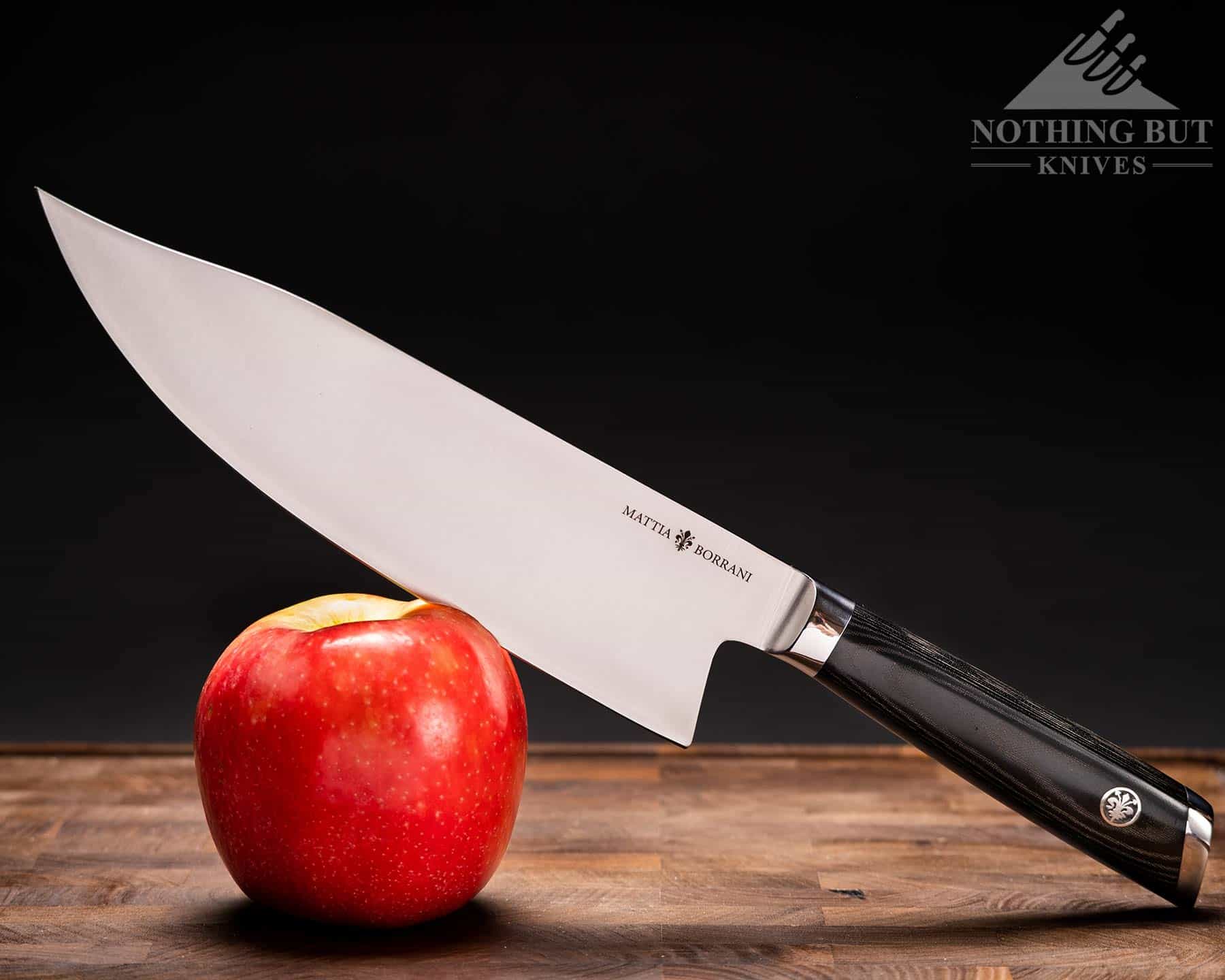
This has become my go-to knife in the kitchen. It’s what I use when I’m not testing a different chef knife. Not necessarily because it outperforms all my other knives (although it does pretty well), but because I just like using it more.
Specifications
| Overall Length: | 13.0” |
| Blade Length: | 8.5” |
| Handle Length: | 4.5” |
| Blade Steel: | San Mai w/ VG-10 core |
| Blade Grind: | Convex and Flat |
| Blade Hardness: | 61 HRC |
| Handle Material: | Micarta |
| Weight: | 8.365 oz |
| Price Range: | $100 – 140 (San Mai), $150 – 200 (Damascus) |
| Designer: | Mattia Borrani |
Pros
| Excellent edge |
| A clip point has a lot of uses in the kitchen |
| Nice balance for such a large knife |
| Minimal oval handle that’s still comfortable |
Cons
| The tall balde can make the pinch grip a little awkward |
| VG-10 steel is good but not great |
| Food sticks to the sides pretty bad |
A Company Close to Home
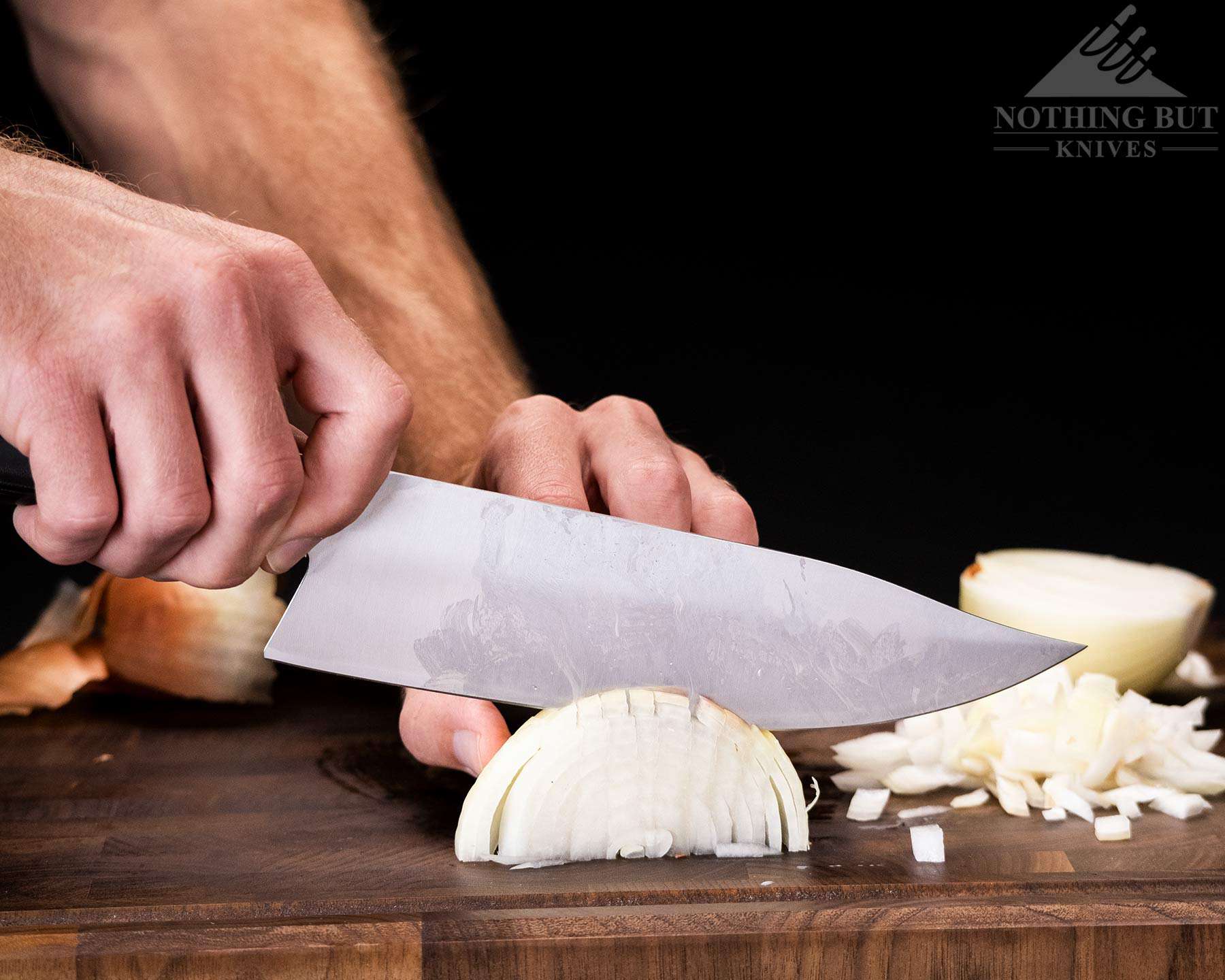
I try to stay up on knife companies operating in the US, but Mattia Borrani Cutlery in particular is a California-based company named after its founder who has a long history in both the culinary and manufacturing world. Borrani actually started out making custom EDC knives with his other company Begg Knives.
The particular model I have was manufactured out of country (I haven’t worked out where exactly), but they do a lot of work in house for their custom models. They’re rolling their own steel, cutting and grinding their own blades, doing their own heat treatments, and making their own handles in a factory in Sonoma County.
They’re also a comparatively small company (which is probably why their production knives are imported), and very much the kind of people that I like to see working and thriving in the industry. On top of the fact that I like this knife for being functionally different, I like where it comes from.
I mostly mention this to warn you that there’s a lot of bias at work in this review. It’s similar to Lamson in that they probably don’t need to make a knife that good before I call it great, because I like the company itself.
Now with all that said: this is a really great knife.
The Blade and Performance
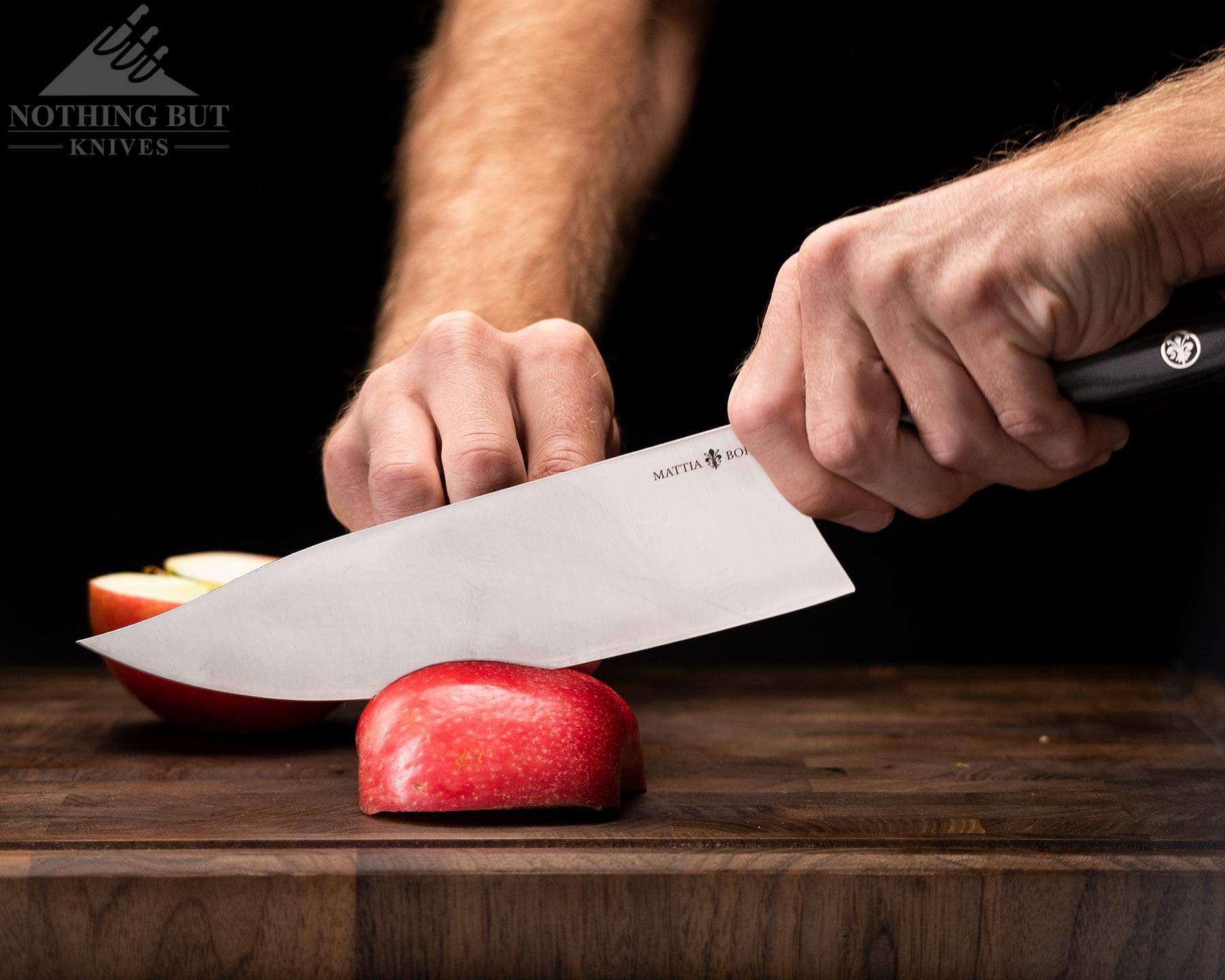
This blade has an absolutely fantastic convex-into-flat compound grind. It doesn’t have a very aggressive bite, but it slices well and has a really smooth follow through when I’m cutting larger things like heirloom tomatoes and eggplants.
When I’m under a heavy workload, I tend to default to a rock chop, but I love doing a draw cut with this knife. Or really any kind of cut with it. Everything feels smooth with this edge, and the size of the blade gives my hand plenty of room to stay clear of the cutting board.
It also seems to be very easy to maintain. Aside from having impressively good edge retention, it responds well to a honing rod. I haven’t had to sharpen it yet, but I think the only thing that will make that a little more difficult is the extreme curve on the blade.
It’s Good Down to a Certain Size
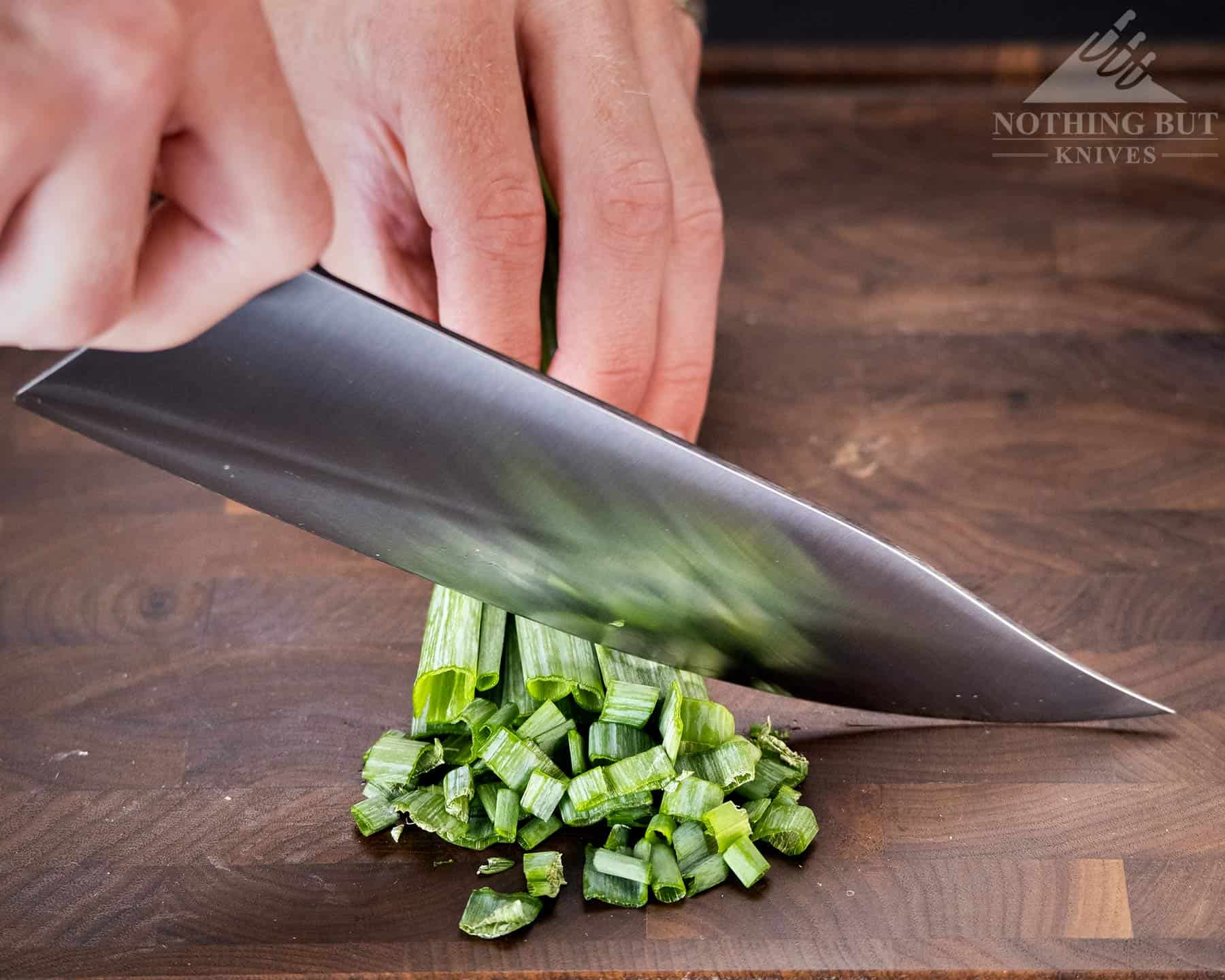
Before I gush about this thing too much, I should mention it’s not a fine cutter. I’ve done a lot of dicing with it, and it’ll get you through pounds of onions, carrots, tomatoes, and whatever without a problem. But if you need your pieces super fine, this isn’t the best knife to grab. It’s sharp enough to cut thin, but the size of the blade and the width of the grind eventually get in the way as you try to cut smaller.
It also has the western-shaped problem of having the tip at the end of a curve so it’s more in line with the spine than the edge, only it’s more pronounced because of the height of the blade. That kind of thing always makes it a little more uncomfortable to do a proper dicing technique on things like onions because I have to angle my hand a lot more to get the cut to go cleanly all the way through.
That problem might be a little more pronounced on this Bowie chef knife because the blade is a bit taller than usual which makes that curve at the top of the blade a little deeper, and by extension I have to angle my wrist more than I would with something like the Zwilling Pro chef knife.
Generally that only comes up as a problem for me when I’m making something like pico de gallo. But this was actually an intentional feature in the design that Borrani put in there in order to allow for higher rock chops, which is more in keeping with how a western chef knife is used anyway. It makes sense because when I’m chopping up anything for a soup or a sauce, this knife does wonders.
The Steel Cladding
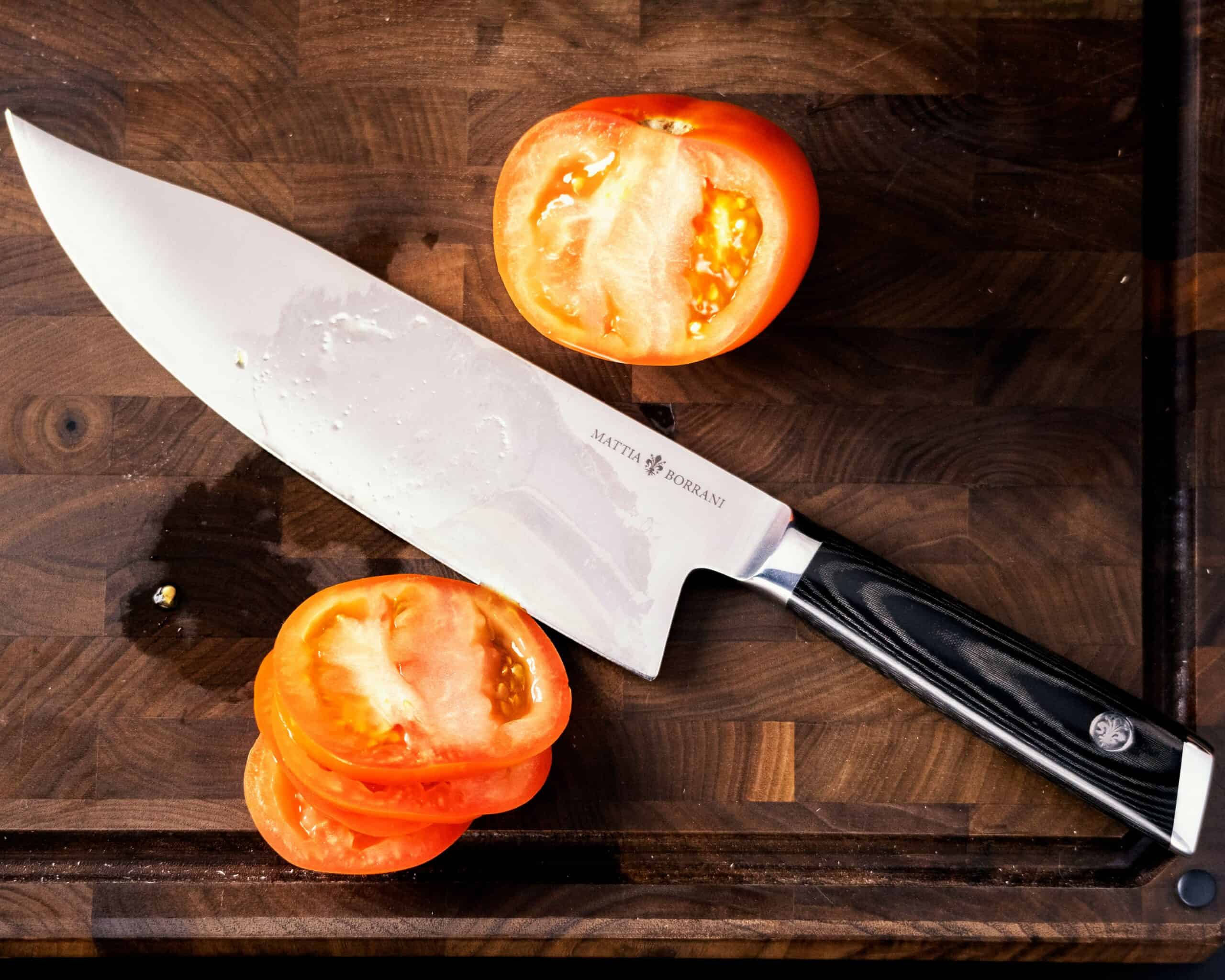
Mattia Borrani makes this knife in a lot of different Damascus steel configurations and designs. The version I have is pretty plain, so I was surprised to learn that it’s actually in a san mai style. It has a VG-10 core with some kind of cladding, but this knife has none of the pronounced lines you typically see in san mai, which leads me to believe this was a purely functional decision.
VG-10 has pretty good corrosion resistance but it can be brittle, so my best guess is that the cladding is there to increase the overall toughness of the blade. VG-10 alone in a blade this size probably has a lot of potential cracking or chipping issues even with a good heat treat, so it’s nice to know there’s a cladding here.
I don’t think I’ve done anything yet that’s really tested the extra corrosion resistance or tensile strength the cladding might bring. This is a fairly thick knife overall, and it looks like it could handle more than your average kitchen knife in terms of physical abuse. So much so that I’m tempted to take it outside and see how far it overlaps with some of our survival knives.
I’m not recommending other people do that by any means. That’s just a thought I have everytime I look at this thing is all.
Where Does the Clip Point Come in
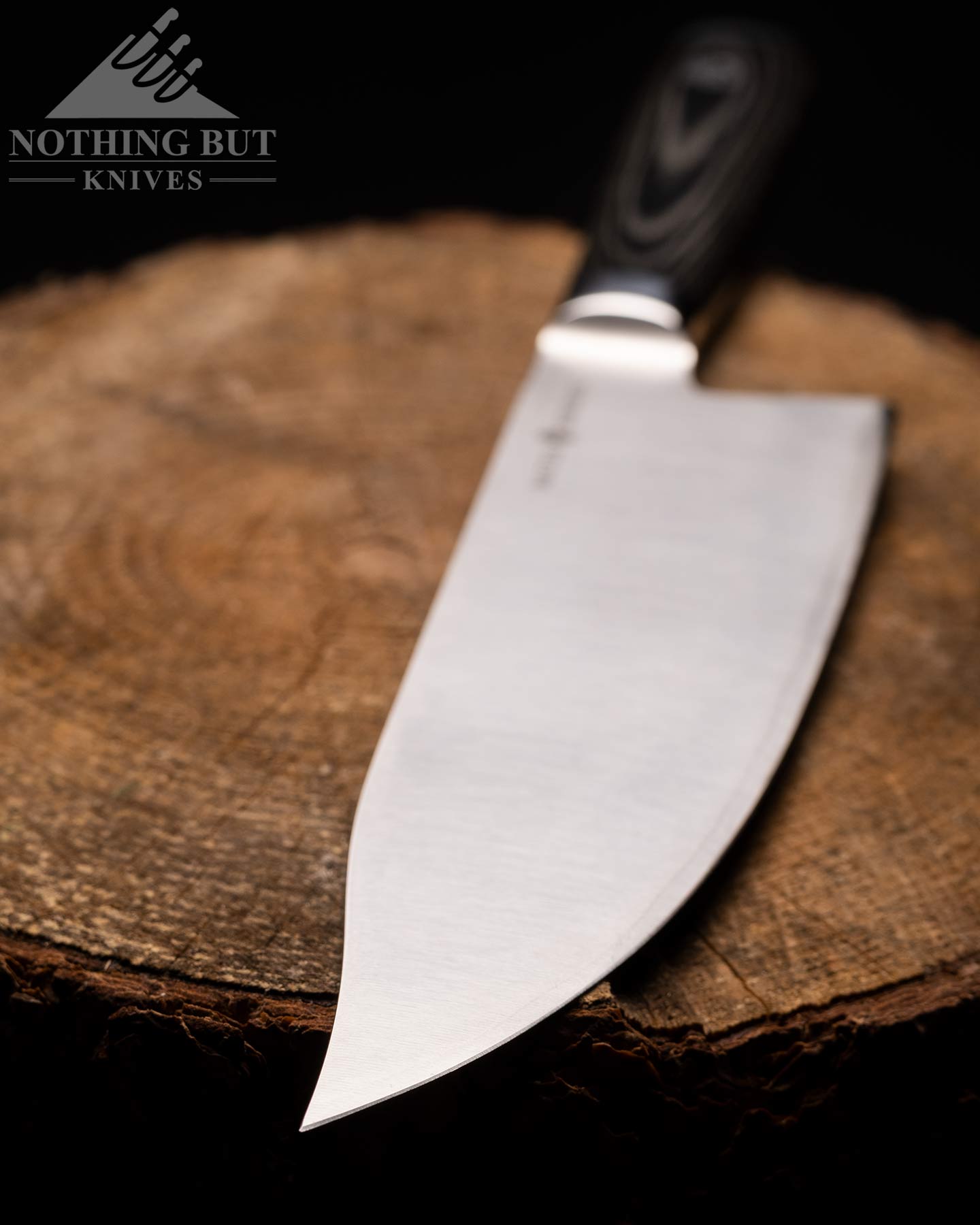
Sometimes you just need something that’s good at poking. That’s what the clip point’s function really comes down to.
In full honestly, I’ve mostly used it to pierce into packaging. I know how to cook, but I still go through phases of living like a bachelor; the Mattia Borrani chef knife has been through a lot of cheese blocks with me.
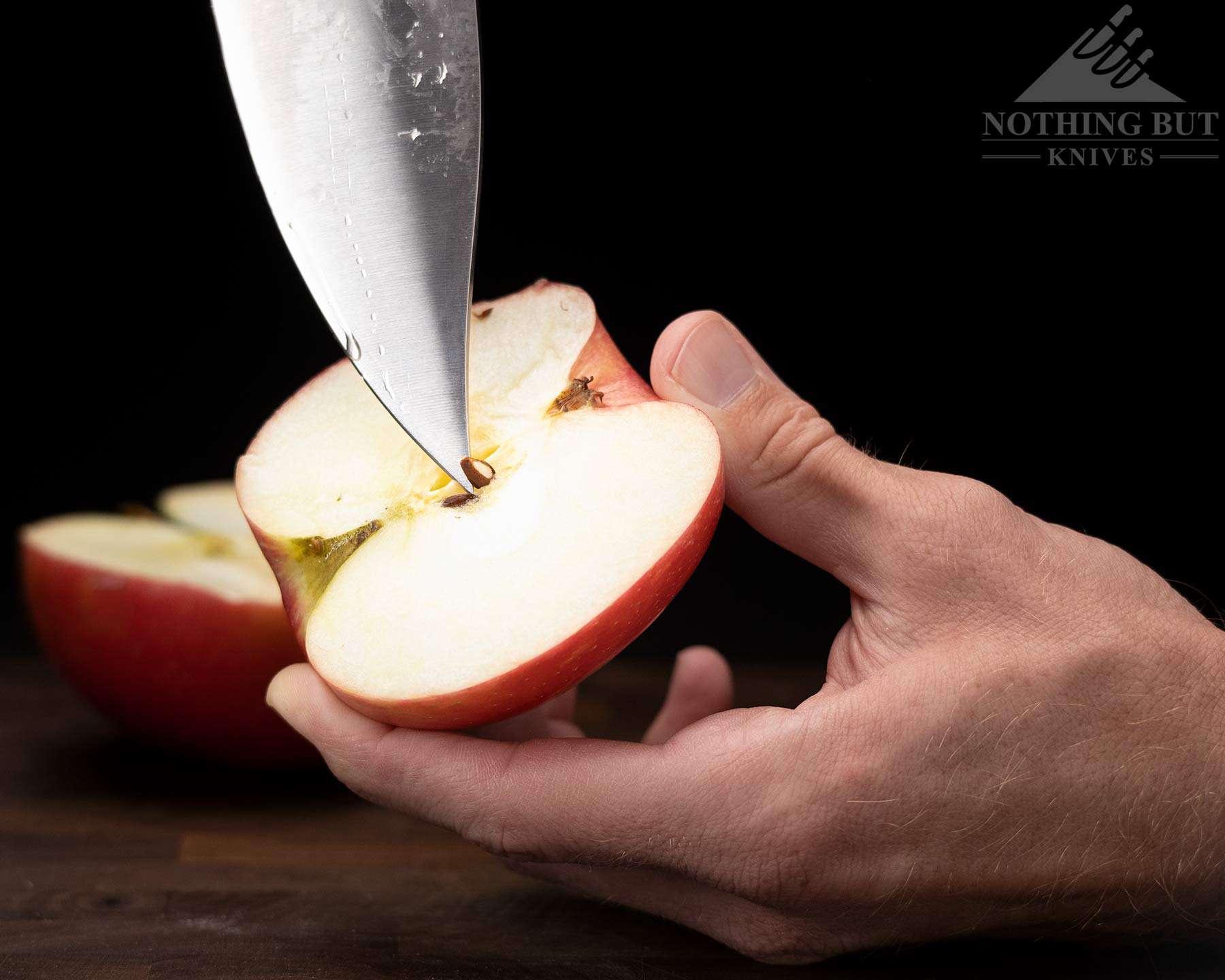
I did eventually realize it’s a pretty good shape for dealing with fruit, though. It turns out the slightly curved point is pretty good for popping out apple seeds. I’ve also used it to core tomatoes, apples, and a few larger strawberries.
Basically what Borrani has done here is put a paring knife blade on the end of his chef knife. It’s definitely not as easy to use as a paring knife, and you can’t hold it like one, but the clip point makes the tip thin enough to do a lot of detail piercing and slicing work in a way that you don’t quite get with traditional German knives.
The Handle and Balance
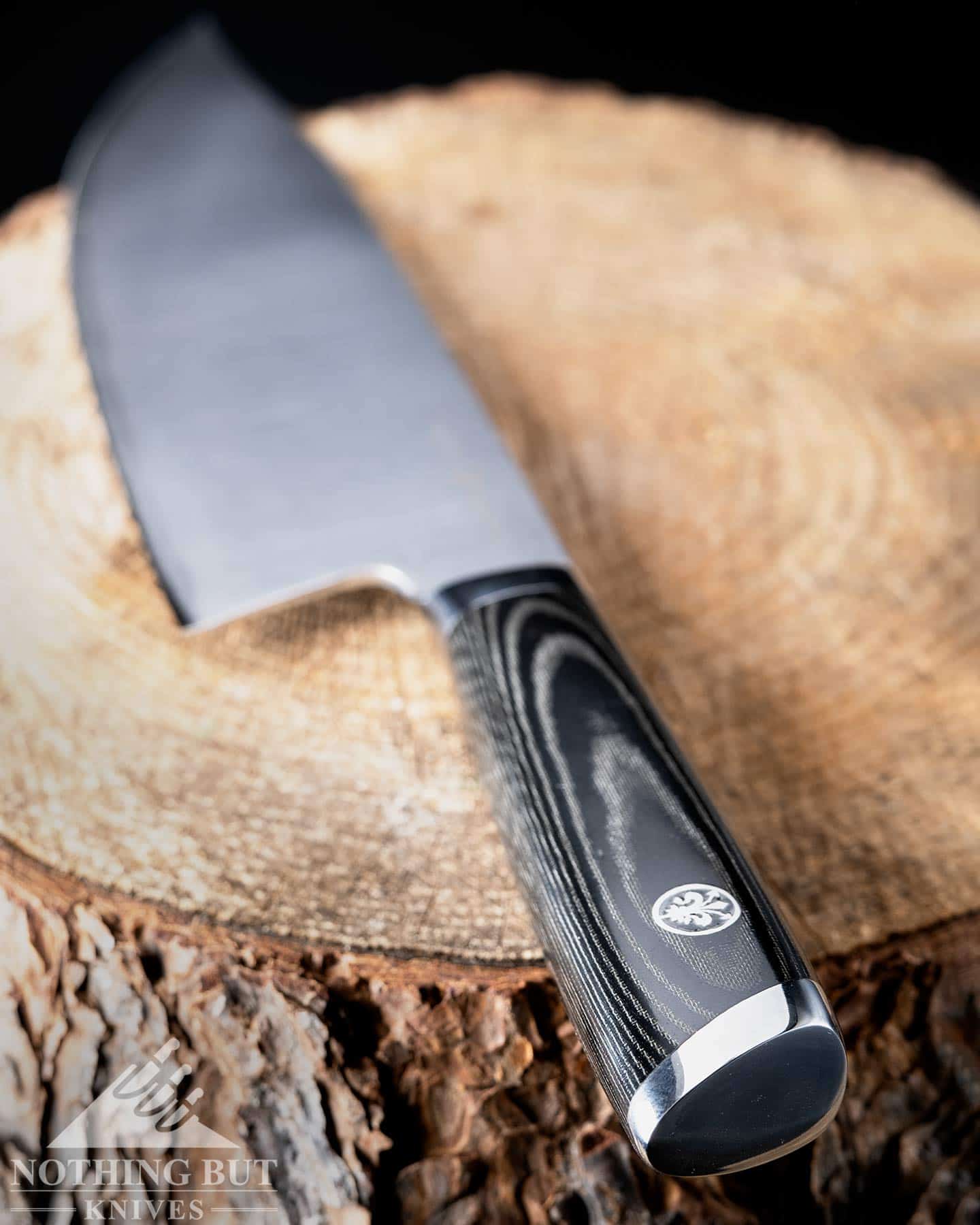
I don’t know exactly how, but this knife is very lightweight.
My main concern when I first saw it was that it would be unwieldy. This has a lot more blade than any other kitchen knife I’ve ever used aside from a cleaver, and it would be really unpleasant if this thing handled like one of those.
Somehow, though, they’ve managed to make the balance really nice on this. It’s actually lighter than every German chef knife I’ve tested. The only one that’s close to this lightweight is the Zwilling Pro S.
The Balance Starts at the Edge
The Bowie Chef knife is definitely blade heavy, but they’ve ground and weighted the handle well enough that the blade is easy and comfortable to control. The top of the handle is shaped well for a pinch grip, and even though the Micarta is pretty smooth it manages to be grippy enough to stay in the hand pretty easily. Plus the weight in the handle offsets the blade, so this whole thing ends up feeling pretty lively in the hand.
That said, this is still a tall blade. The cleaver comparison is apt here. There’s a lot of material in front of your fingers, and while that’s great for knuckle clearance, it does make the ergonomics of a pinch grip feel more front heavy than most people are used to even if they’ve been using German style knives for a while.
There’s Plenty of Room for Different Grips
If you have your fingers right on the slope of the bolster you’ll probably feel the weight leaning just a bit in front of your grip, right about where the edge starts. That’s been enough for me to shift my grip a little higher on the blade than I normally do, but that gets back into the great thing about how tall this blade is, and how well the handle is shaped.
There’s plenty of room for me to find a different grip on the blade, and the curves of the handle make it pretty easy to find another comfortable place for the bottom part of my hand to find purchase.
So Has Mattia Borrani Really Made an American Chef Knife?
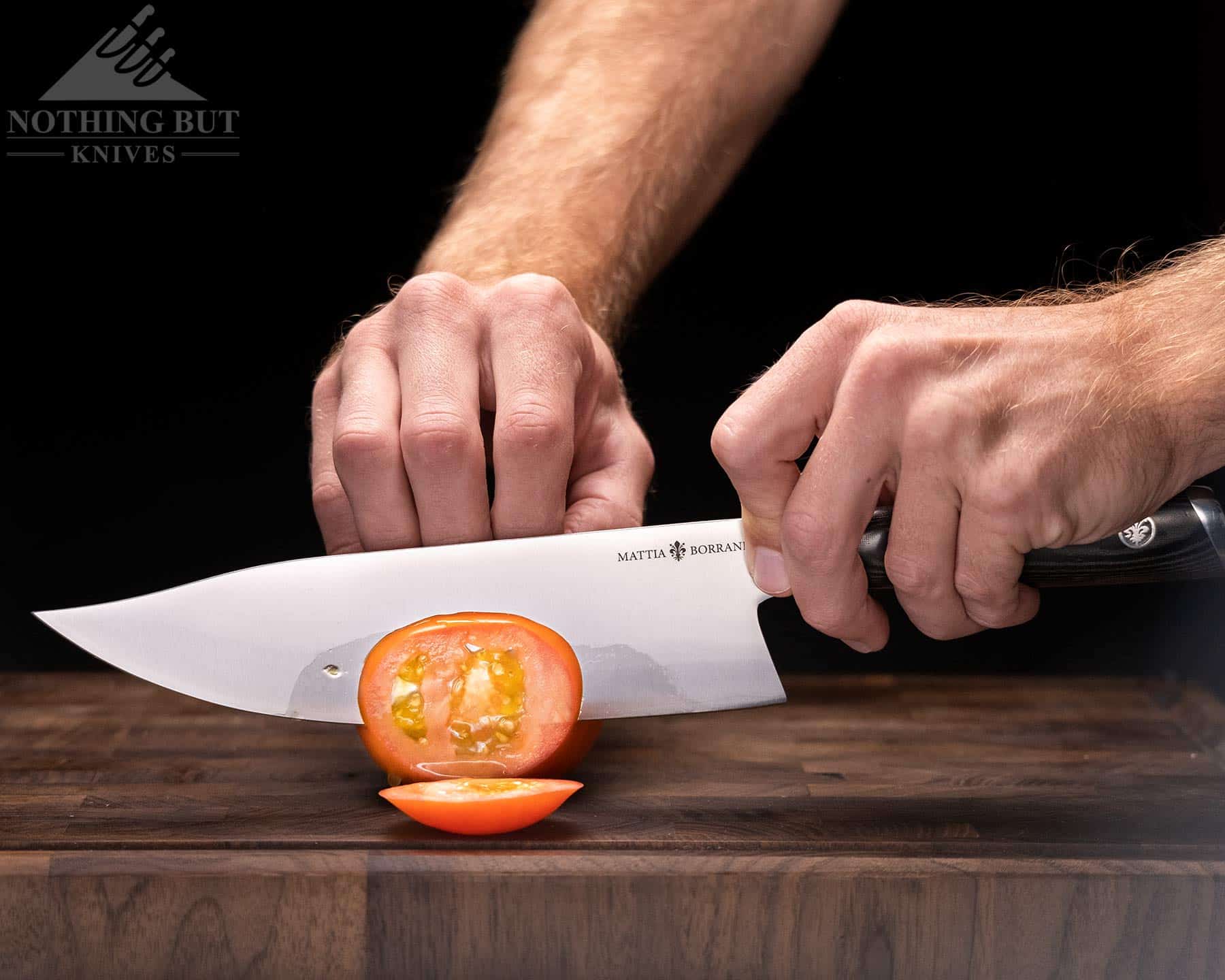
Mattia Borrani designed his bowie chef knife with the specific intention of creating a kitchen knife that felt “American”. Since the culinary world is dominated by a German or Japanese binary, he felt it was time that the US had its own category in the mix.
I don’t know that slapping a bowie blade on an oval handle necessarily accomplishes that, but it has resulted in a pretty fantastic kitchen knife. Enough that I feel bad about constantly referring to this as a “western chef knife” in the same way I would a Messermeister or Wusthof knife.
But the fact is that when I first saw the knife I thought it was a weird looking German knife before I realized what the shape actually was. And then I thought it was Italian because Mattia Boranni sounds vaguely like a name I might hear whispered fervently over a plate of oranges in the Godfather.
The pin depicting some kind of fleur de lis doesn’t help place this thing, either.
But frankly, I wouldn’t know how to define an American knife at this point. I think the knives we tend to associate automatically with the US are folders like the Buck 110 and one of the Case barlows. With fixed blades most of us probably think of the Ka Bar Mark series. Those all have some kind of clip point variation that follows the bowie knife style, so Borrani is onto something there. But it feels like there’s an element missing with the handle.
I think it comes down to the Bowie Chef knife being made too economically. It has a fantastic handle, but it’s too slim to really jump out as unabashedly American. I guess what I’m saying is this knife just doesn’t look fat enough to look completely American.
That said, in the sense that America has always been about a melting pot of people struggling to rise through hard work and innovation, this is absolutely an American knife. It just needs a beer belly to get all the way there.
Comparison and Alternatives
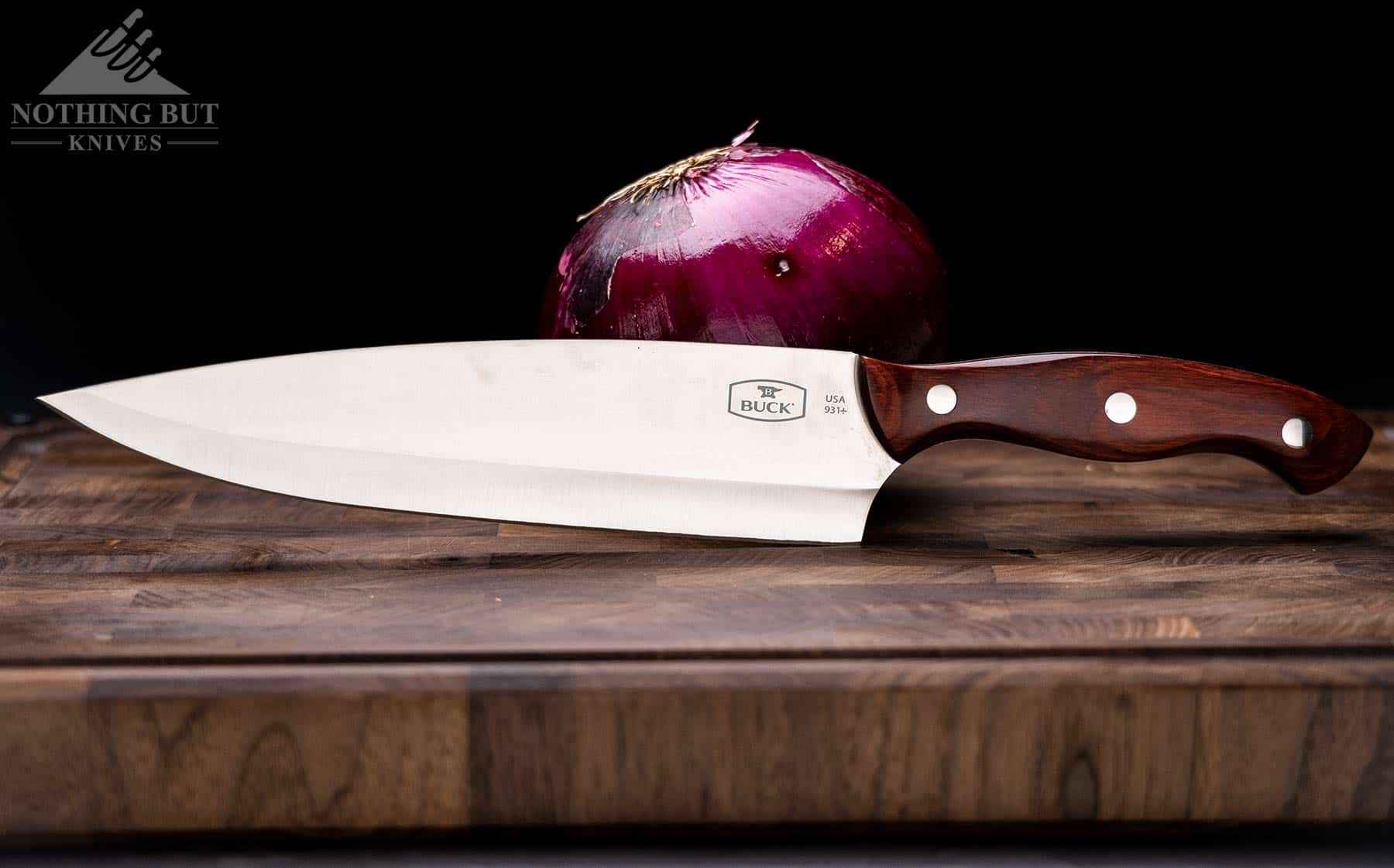
It’s kind of tricky to recommend alternatives to this knife. There aren’t a lot of bowie chef knives available outside the custom knife world. I brought up a few German knives in the review that are worth looking at, but as long as Borrani is pushing for an American style knife, I’ll recommend knives made by other American companies.
First up is the Lamson Premiere Forged chef knife. It has a similar edge on it and a really comfortable handle. It’s also about the same price, but the steel is just a plain 1.4116, so it falls short on edge retention. It’s pretty tough, though.
Buck’s chef knife doesn’t look very similar at first, but it has the same feeling of being adapted from a knife with a different purpose. The Buck has an edge that’s pretty similar to a lot of their pocket knives, and the handle definitely has some Alpha hunter vibes. The ergonomics will be a lot different from Borrani’s Bowie knife, though, both because the Buck isn’t optimized for a pinch grip, and because it’s over an ounce lighter. But it is a super thin slicer.
I should also bring up the Damascus version of the Mattia Borrani design. I haven’t handled it personally, but from looking at the specs I don’t see any reason why it would perform differently. The Damascus is still using a VG-10 core, and the handle is the same. But, depending on the design, it can raise the price anywhere from $50 to $100. I’m not gonna sit here and tell you that you’ll get $100 worth of extra enjoyment from the Damascus version, but I will tell you that there isn’t much in the way of options for other Damascus bowie chef knives in this price range from a reliable company, and while it’s debatable whether Damascus actually makes knives better, I do like the designs Mattia Borrani is making with his.
It would be cool if there were a Mattia Borrani Bowie set available with knives of different sizes. It would make a fun high-end knife set.
Unique and Practical
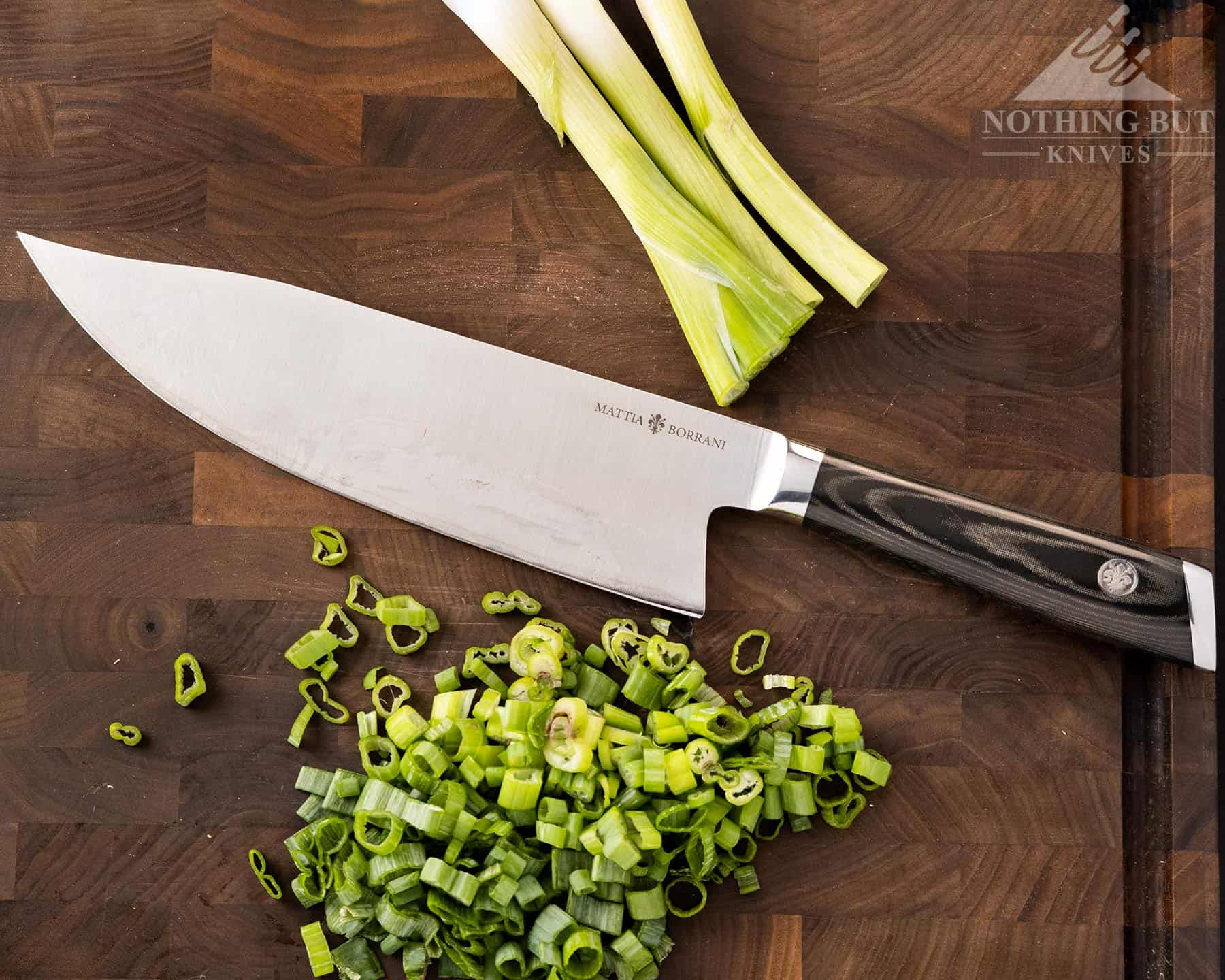
This is a great knife, but if I’m being totally honest with myself, the main reason I love it more than almost any other blade in my kitchen is that it’s a big bowie knife that works, and that I can use regularly.
I spend a fair amount of time outdoors hiking and camping and testing other knives, but I rarely have a genuine need for a bowie knife.
When I’m cooking or baking I always end up needing to use this for something, and it just makes me unreasonably happy to pull this out to section off dough or dice an onion. It’s not the best knife I could be using, but it’s designed well enough to be a good tool for everything I’m doing. It’s even a good knife for the price considering the plain San Mai version usually sits at around $100.
I don’t know if I would recommend this for professional work, although from what I’ve seen, there are professionals using it out in the world. But if you like bowie knives, or you’re just looking for something different to throw into your kitchen line up, you absolutely should get this knife. Don’t try to justify it. Just get it and enjoy yourself.

Hey
I need to visit Mattia Borrani pages and see if they ship to Norway. 😉
They’re definitely fun to have. I don’t know if Mattia Borrani ships overseas. Some of the US vendors that carry them like Blade HQ might, though.
They ship overseas, but I just discovered it is almost just as expensive as the knives.